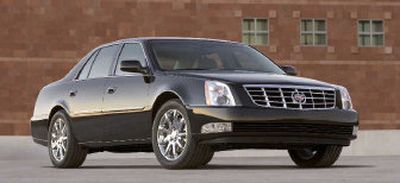DeVille enters new era as DTS

As the world forces it to change or die, Cadillac runs the risk of changing too much too fast.
Unquestionably, its long-term hopes reside in such Euro-centric sport-sedans as the CTS and STS. But a fair trade is still done in traditional luxury sedans, long the company’s stock-in-trade, and Cadillac can ill afford to ignore those buyers.
The DeVille has been the company’s standard-bearer in the full-size luxury category ever since Cadillac spun up the STS and sent it out to battle BMW’s 5-series; for the past 20 years, the big front-driver has accounted for nearly half of all sales in the full-size, front-drive luxury segment.
But the DeVille nameplate belonged to a time past. It dates to the 1949 introduction of the Coupe DeVille, a car whose chrome-and-fin excesses became metaphoric for the abundant (and some would say phallic) ripeness of post-war America.
Whatever fading images the name evoked, though, DeVille owners were true blue, and so for 2006 Cadillac has jettisoned the name but not the vehicle.
The ‘06 DTS is a DeVille in all but name, a big, quiet and comfortable sedan, now outfitted with a whiff of import understatement but imbued nonetheless with an All American ethos. Equipped with the standard-issue bucket seats, it’s ready for an evening out with company; order it with the optional front bench and it’s a just-right ride for you, the spousal unit and four grandkids.
And unlike its new-school siblings with their firmed-up suspensions, the DTS trades in a ride that pleases those who’d rather ignore the hard, cold facts of terra firma.
Underneath, the DTS (from $41,990, including destination) has not changed much from the DeVille of ‘05. A 4.6-liter V-8 still pumps out 275 or 291 horsepower, depending on the trim level chosen, and the fully independent suspension produces a gently damped ride.
General Motors’ electronic steering system is tuned here for crisp, immediate turn-in and good on-center feel and the four-wheel disc brakes, with ABS, are larger this year and provide the stopping power and control required of a big sedan these days.
To enhance ride quality and reduce noise, vibration and harshness, Cadillac engineered a new front-cradle design, with the engine mounted to the cradle, which in turn is mounted to the body rails.
You can get all the engineering right, though, and still alienate potential owners if you do the design wrong. Cadillac’s edgy, all-angles “Art & Science” look has earned adherents among younger drivers but was perceived as perhaps a bit much for the established set. Credit Cadillac designers for updating their flagship with crisp lines and sharp edges without disrupting the proportions and styling cues that have helped make the Seville such a success.
Basic body panels remain unchanged, but crisp, new front and rear sheet metal update the Seville and bring it into line with the rest of the family.
Freshened cabin design centers around higher-quality materials and improved fit-and-finish. Cadillac claims interior gaps measure 5 millimeters or less, on par with the world’s best.
Designers lowered the instrument panel and moved it slightly forward to enhance the feeling of spaciousness. A new analog clock and optional burl walnut trim add a touch of elegance.
To provide the initial softness traditional buyers equate with comfort, without sacrificing support, seats are fashioned of dual-density foam, with a soft layer atop a firmer core. Seat travel is increased by an inch and a full complement of airbags includes an industry first “dual-depth” bag on the front passenger side.
The steering wheel tilts but does not telescope and GM needs to deep-six the tilt function that allows adjustments in large increments only.
The DTS is marketed as a single model, with three available options packages, Luxury II, Luxury III and Performance.
The base trim includes tri-zone automatic climate control, leather upholstery, OnStar, bi-Xenon headlights, power front seats and one-touch windows.
Surprisingly, our tester, which was equipped with the Luxury II options package ($2,500; see Optional Equipment below), included only a single-play CD player. A six-CD unit would have been available as part of a $1,795 Sun and Sound options package with Bose audio system, garage-door opener and moonroof.
Or we could have stepped up to the Luxury III package ($6,500) that would have added automatic leveling headlights, burl walnut trim, power folding mirrors, leather-and-wood wrapped and heated steering wheel with power tilt and telescope, rain-sensing wipers and 17-inch, nine-spoke chrome aluminum wheels.
The top options package, the Performance ($8,500) brings on the stronger engine, performance-algorithm shift patterns, Magnetic Ride Control suspension, 18-inch tires and machined aluminum wheels.
Cadillac has done the right thing moving the DeVille into modern times. Still, the passing of the iconic nameplate provokes a twinge of regret.
In fact, the DeVille lost its true identity years ago, perhaps when the first Sedan DeVille appeared in 1955 and certainly 30 years later when it became a front-driver. But as Chuck Berry and a generation of mythmakers after him knew, nothing said America like DeVille.